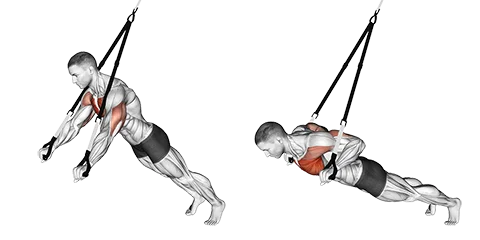Introduction
The "Ring Chest Press" exercise targets your chest, shoulders, and triceps using gymnastic rings as resistance. It strengthens these muscle groups while improving upper-body stability and balance. This exercise is particularly effective for individuals aiming to build functional strength, increase muscular endurance, or prepare for sports requiring upper body power and control.
Muscles Worked
- Primary: Chest (Pectoralis Major), Shoulders (Deltoids)
- Secondary: Triceps, Core (Abdominals)
How to Do It (Step-by-Step)
- Sit on a chest press machine with your back flat against the pad and grasping the handles at shoulder width.
- Push the handles forward, keeping your elbows at a 90-degree angle, until they are nearly straight but not fully locked out.
- Lower the handles slowly, returning to the starting position while maintaining control throughout the movement. Keep your core tight and avoid excessive arching of the back.
Tip: Maintain proper posture throughout the exercise by keeping your shoulders down and away from your ears, focusing on squeezing the chest muscles during the press motion.
Rep & Rest Guidelines
- Strength: 4–6 reps, 2–3 min rest
- Hypertrophy: 8–12 reps, 60–90 sec rest
- Endurance: 12–20 reps, 30–60 sec rest
Using auto progression Auto Progression can help you reach your fitness goals efficiently. Never forget a rest again with the built-in rest timer Rest Timer.
Form Tips
- Maintain a stable base of support by keeping your feet flat on the floor and your back firmly against the bench.
- Keep your elbows at a 45-degree angle to your body throughout the movement.
- Exhale as you push the weights away from your chest, then inhale as you slowly return them to the starting position.
When to Use It
- Strengthening upper body for swimming: Ring chest press targets the chest, shoulders, and triceps effectively, improving muscle strength needed for a strong swim stroke.
- Building functional strength for gymnastics: This exercise helps develop the pushing power required in movements like the planche, ring dip, or muscle-up.
- Enhancing push-up variations: Ring chest press is an advanced variation of a push-up that can challenge your muscles and help you progress to more difficult push-up exercises.
Workout History can help you track and analyze your workout progress over time.
The primary muscles worked are the pectorals, triceps, and deltoids.
A common routine is 3-4 sets of 8-12 reps, adjusting based on your fitness level.
Yes, you can perform ring dips, which are similar but may require more upper body strength.
Keep your back straight, lower your chest between the rings, and push up explosively.
Include it 2-3 times per week for optimal results while allowing sufficient recovery time.

